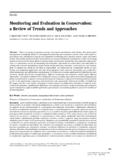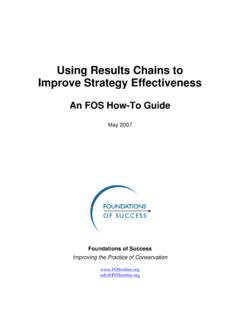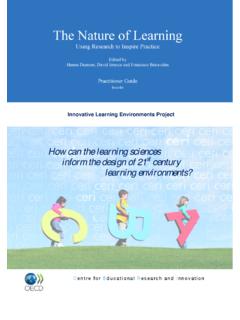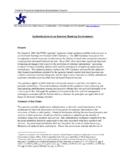Transcription of Adaptive Management - FOS Online
1 Adaptive Management : A Tool for Conservation Practitioners Nick Salafsky Richard Margoluis Kent Redford Table of Contents What is This Guide About? Introduction Sources for This Guide Steps in the Process of Adaptive Management principles for the Practice of Adaptive Management Where Do We Go from Here? References Acknowledgments, Publication Credits For More Information This publication was produced by the Biodiversity Support Program (BSP), a consortium of World Wildlife Fund, The Nature Conservancy, and World Resources Institute.
2 Although BSP ended in 2001, many of the activities it undertook including Adaptive Management , monitoring and evaluation, and applied research and learning are being carried on by the non-governmental organization Foundations of Success (FOS). For more information on this publication or FOS, please contact us at: Foundations of Success 4109 Maryland Avenue Bethesda, MD 20816 USA Phone: +1 703 764-8572 Fax: +1 703 764-0179 E-mail: Website: Adaptive Management :A Tool for Conservation PractitionersPerhaps you are a memberof a project team that isresponsible for managing a biosphere reserve or national park.
3 Maybe youwork for a non-governmental conservation organization that is doingcommunity-based conservation in an area rich in natural resources. Perhapsyou are a research scientist or graduate student trying to figure out the best wayto conserve an ecosystem in a particular area. Or maybe you work for agovernment agency responsible for managing natural resources in a certain stateor roles are typical of conservation practitioners people who work onprojects that are designed to achieve goals related to biodiversity conservationand the sustainable Management of natural resources.
4 If you are like mostContents:What Is This Guide About?4An Introduction to Adaptive Management10 Sources for This Guide18 Steps in the Process of Adaptive Management32 principles for the Practice of Adaptive Management64 Where Do We Go From Here?88 For the Summary of the Framework for AdaptiveManagement Presented in This Guide, please see page 13 principles OF Adaptive MANAGEMENTWHERE DO WE GOFROM HERE?STEPS INADAPTIVE MANAGEMENTSOURCES FOR THIS GUIDEINTRODUCTION TOADAPTIVE MANAGEMENTWHAT IS THIS GUIDEABOUT?
5 PRINCIPLESFOR PRACTICEWHERE DO WE GOFROM HERE?STEPS INADAPTIVE MANAGEMENTSOURCES FOR THIS GUIDEINTRODUCTION TOADAPTIVE MANAGEMENTWHAT S THIS GUIDEABOUT? 11/9/01 11:30 AM Page iiPRINCIPLES OF Adaptive MANAGEMENTWHERE DO WE GOFROM HERE?STEPS INADAPTIVE MANAGEMENTSOURCES FOR THIS GUIDEINTRODUCTION TOADAPTIVE MANAGEMENTWHAT IS THIS GUIDEABOUT? Adaptive Management : A Tool for Conservation Practitioners|3 What actions should we take to efficiently achieve our goals? How do we measure our success and the extent to which our actions contributed to change?
6 What can we do to work more effectively in the future? How can we capture what we have learned so that we don t make the samemistakes again? How can we share our findings with other practitioners?If you have ever asked yourself questions like these, then you have begunthe process of Adaptive OF Adaptive MANAGEMENTWHERE DO WE GOFROM HERE?STEPS INADAPTIVE MANAGEMENTSOURCES FOR THIS GUIDEINTRODUCTION TOADAPTIVE MANAGEMENTWHAT IS THIS GUIDEABOUT?2| Adaptive Management : A Tool for Conservation Practitionersother conservation practitioners, your work requires a wide range of skillsincluding managing staff, dealing with boards, funders, and bosses,communicating with stakeholders, and understanding the biology and cultureof the places in which you work.
7 But perhaps more importantly, your jobrequires understanding and managing information in ways that maximize yourconservation results. Like many other conservation practitioners, you have probably asked thefollowing questions as you have managed your project: How can we best understand the conditions at the site where we areworking? What goals should we be trying to accomplish? 11/9/01 11:30 AM Page 2 principles OF Adaptive MANAGEMENTWHERE DO WE GOFROM HERE?STEPS INADAPTIVE MANAGEMENTSOURCES FOR THIS GUIDEINTRODUCTION TOADAPTIVE MANAGEMENTWHAT S THIS GUIDEABOUT?
8 Adaptive Management : A Tool for Conservation Practitioners|5in using different tools and techniques in their work. As a result, they havebegun examining what works, what doesn t, and why. And finally, conservationpractitioners are being asked to capture what they have learned and pass it onto other practitioners so that we can avoid making the same mistakes over andover again and can begin generating new knowledge. They have thus begun totry to create learning projects and learning and evaluation, testing what works and what doesn t, andcreating learning organizations are all components of an approach calledadaptive Management .
9 Adaptive Management is fundamentally a way of incorporating reflection into action to enhance the practice of conservation and OF Adaptive MANAGEMENTWHERE DO WE GOFROM HERE?STEPS INADAPTIVE MANAGEMENTSOURCES FOR THIS GUIDEINTRODUCTION TOADAPTIVE MANAGEMENTWHAT S THIS GUIDEABOUT?4| Adaptive Management : A Tool for Conservation PractitionersWhat is This Guide About?The field of biodiversity conservationis at an important point in its evolution. Over the past few decades, we havediscovered why conservation is important to maintain life on Earth.
10 We haveidentified many of the species and ecosystems that are at greatest risk of goingextinct. And we have begun to develop tools and techniques that can helpcounter the growing threats to the same time, as the field matures, the conservation community is alsofacing a number of new and more difficult challenges. Perhaps foremostamongst these is the recognition that despite decades of hard work, hundredsof projects, thousands of trained professionals, and millions of dollars, we havenot yet substantially slowed the destruction of forests, grasslands, and aquaticecosystems.








